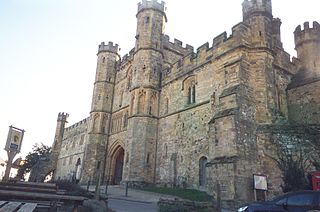Related Research Articles

Abbotsbury Abbey, dedicated to Saint Peter, was a Benedictine monastery in the village of Abbotsbury in Dorset, England. The abbey was founded in the 11th century by King Cnut's thegn Orc and his wife Tola, who handsomely endowed the monastery with lands in the area. The abbey prospered and became a local centre of power, controlling eight manor houses and villages. During the later Middle Ages, the abbey suffered much misfortune. In the time of the dissolution of the monasteries, the last abbot surrendered the abbey and the site became the property of Sir Giles Strangways.
The Abbot of Abingdon was the head of Anglo-Saxon and eventually Benedictine house of Abingdon Abbey at Abingdon-on-Thames in northern Berkshire, England.
Henry Murdac was abbot of Fountains Abbey and Archbishop of York in medieval England.
Michael David Knowles was an English Benedictine monk, Catholic priest, and historian, who became Regius Professor of Modern History at the University of Cambridge from 1954 to 1963. His works on monasticism in England from the times of Dunstan (909–988) to the dissolution of the monasteries are considered authoritative.
Eynsham Abbey was a Benedictine monastery in Eynsham, Oxfordshire, in England between 1005 and 1538. King Æthelred allowed Æthelmær the Stout to found the abbey in 1005. There is some evidence that the abbey was built on the site of an earlier minster, probably founded in the 7th or 8th centuries. The site is a Scheduled Historic Monument.
Sigar was an Anglo-Saxon Bishop of Wells.
Leofrun was the abbess of St Mildred's, Minster-in-Thanet, Kent, a Benedictine abbey for nuns.

Gloucester Abbey was a Benedictine abbey in the city of Gloucester, England. Since 1541 it has been Gloucester Cathedral.

The Abbot of Gloucester was the title of the head of Gloucester Abbey in Gloucester, England.
Abbot of Bury St. Edmunds was the title used by the head of the Benedictine monastery Bury St. Edmunds Abbey in the county of Suffolk, England. The following table lists the abbots from the foundation of the abbey in 1020 until its dissolution in 1539.
Abbot of Battle was the title given to the abbot of Battle Abbey in Sussex, England. The abbey was founded in 1067 by William the Conqueror and the first abbot was Robert Blanchard, who drowned soon after his appointment. The following table gives the abbots from the founding of the abbey until 1216, and is from Heads of Religious Houses: England and Wales 940–1216.

Walter de Luci, Abbot of Battle Abbey, was the brother of Richard de Luci, who was Chief Justiciar of England.
The Abbot of Glastonbury was the head of Anglo-Saxon and eventually Benedictine house of Glastonbury Abbey at Glastonbury in Somerset, England.
The Abbot of Crowland was the head of Crowland Abbey, an English monastery built up around the shrine of Saint Guthlac of Crowland by King Æthelbald of Mercia, and refounded as a Benedictine house circa 948. The last abbot was John Wells, who was constrained to surrender the monastery to the king's agents during the Dissolution of the Monasteries in 1539.
The Prior of Durham was the head of the Roman Catholic Durham Cathedral Priory, founded c. 1083 with the move of a previous house from Jarrow. The succession continued until dissolution of the monastery in 1540, when the priory was replaced with a Church of England deanery church.
The Chronicon Abbatiae de Evesham or Chronicle of the Abbey of Evesham, sometimes the Evesham Chronicle, is a medieval chronicle written at and about Evesham Abbey in England.
The Abbot of Evesham was the head of Evesham Abbey, a Benedictine monastery in Worcestershire founded in the Anglo-Saxon era of English history. The succession continued until dissolution of the monastery in 1540:
Bedford Abbey was a short-lived Benedictine monastery, recorded in 10th century England. Bedford Priory, perhaps representing the same institution two centuries later, was an Augustinian priory that within two decades of its foundation moved to nearby Newnham.
Roger of London was an English Benedictine monk and Abbot of Selby Abbey from 1189 to 1195.
Walter, Abbot of Evesham or Walter de Cerisy was an 11th-century abbot and church leader of England under the Norman conquest. He is known from the Domesday Book and several legal documents.
References
- Knowles, David; Brooke, C. N. L.; London, C. M, eds. (1972), The Heads of Religious Houses : England and Wales. 1, 940—1216, Cambridge: Cambridge University Press, ISBN 0-521-08367-2
- Greenslade, M. W.; Pugh, R. B., eds. (1970), "Houses of Benedictine Monks: The Abbey of Burton", A History of the County of Stafford: Volume 3, British History Online, pp. 199–213, retrieved 2009-07-09
- Smith, David M.; London, C. M, eds. (2001), The Heads of Religious Houses : England and Wales. 2, 1216—1377, Cambridge: Cambridge University Press, ISBN 0-521-80271-7